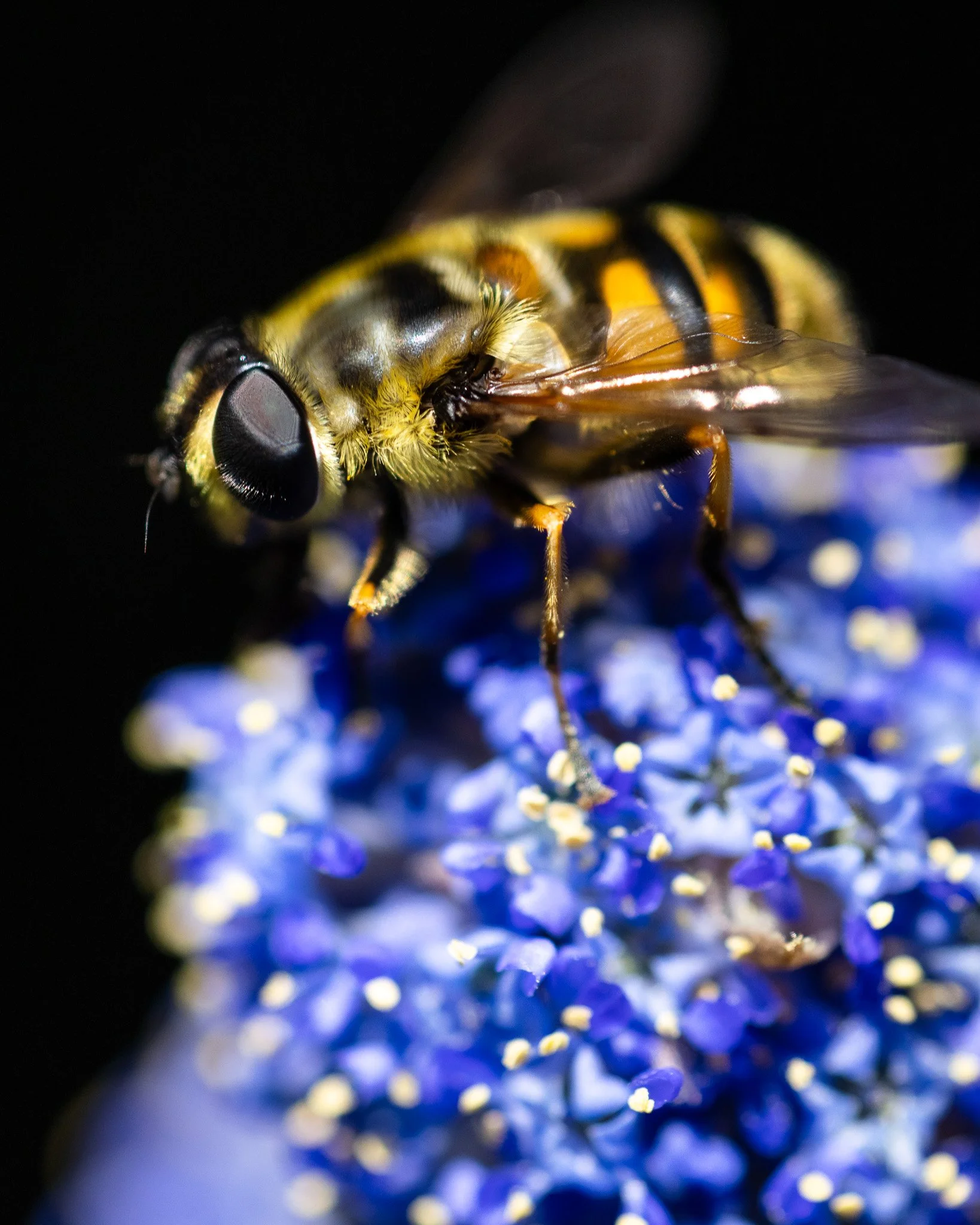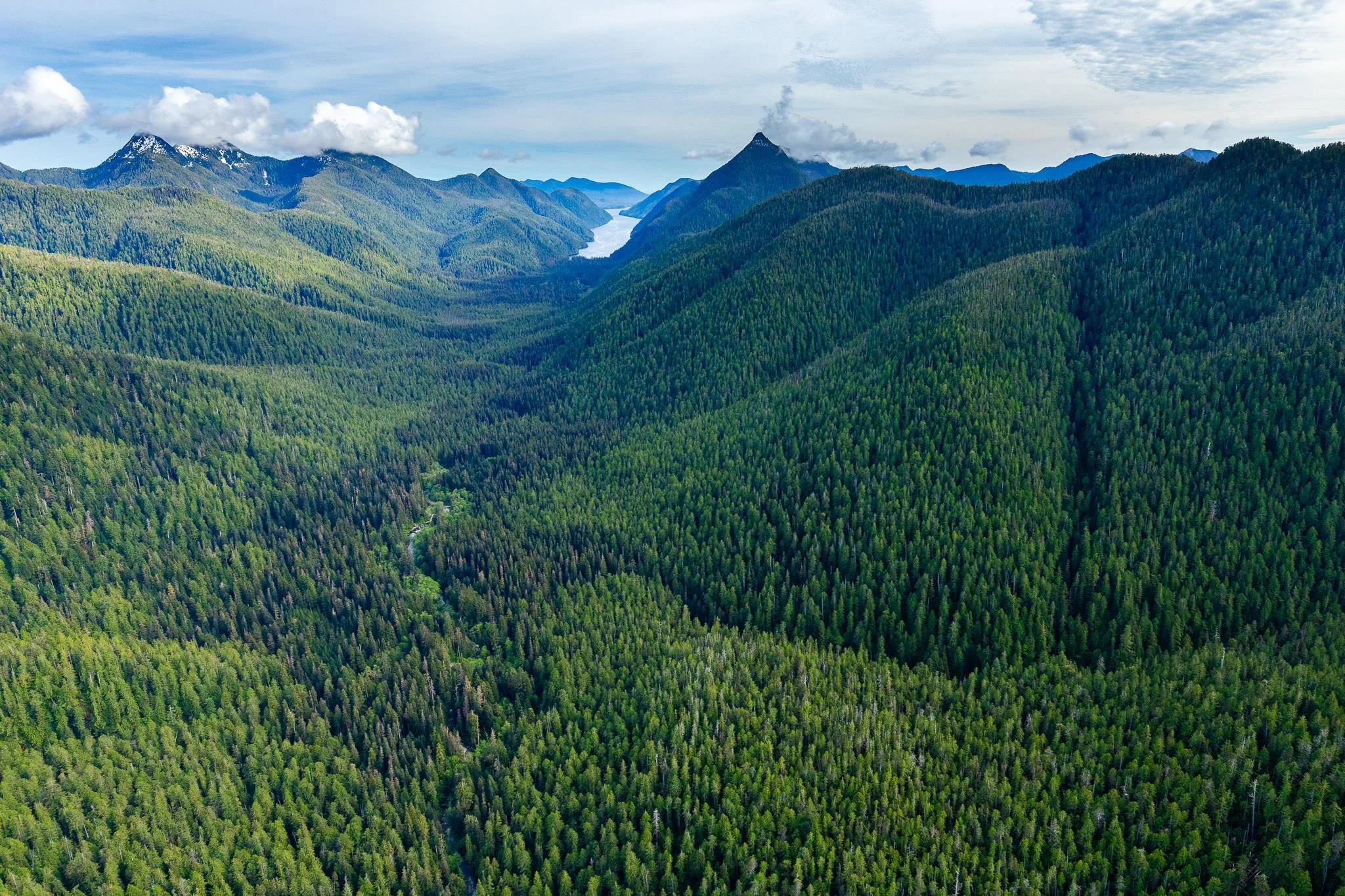What could this “bee”? Well… not a bee at all! This is the common drone fly (Eristalis tenax), a master of mimicry. Its honeybee look keeps predators away, but its real role is pollination, carrying tiny grains of life from one bloom to the next. I stumbled on it while photographing bumblebees in my backyard. It even had me fooled until I looked more closely! 🐝
The Golden Hinde – Vancouver Island's Tallest Peak
The Golden Hinde. At 2,195 metres (7,200 feet), it’s the tallest peak on Vancouver Island.
Rising from the rugged heart of Strathcona Park, this summit is composed of ancient volcanic rock known as the Karmutsen Formation – basalt that erupted over 200 million years ago when this land lay beneath the ocean.
Getting there isn’t easy, though. Most routes involve 50+ kilometres of hiking over five days, with exposed scrambling along the way. Not for the faint of heart!
I haven’t made the trek myself (yet), but drop a note below if you’ve taken in the view from the island’s highest point!
Volcano Lake ~ Strathcona Park
Like a sapphire set in stone, Volcano Lake shimmers deep within Strathcona Park.
Despite its name and crater-like shape, this alpine gem was sculpted not by fire, but by ice.
Carved by ancient glaciers, the cirque forms a dramatic bowl that now cradles the lake. Perched at roughly 1,300 metres and surrounded by rugged peaks like Puzzle Mountain, it remains one of the park’s most remote and awe-inspiring alpine lakes.
Pretty incredible peering into its dark blue eye from above! 🏔️
Tzela Lake ~ Strathcona Park
The turquoise waters of Tzela Lake shine like a heart-shaped jewel amid the rugged mountains of Strathcona Park 🩵
Almost candy-like in tone (rocket freezies?), the lake gets its creamy blue colour from “rock flour”, fine glacial silt suspended in meltwater.
Flanked by The Red Pillar and perched at 1,100 metres, the lake sits deep within the park. Be prepared for a long and challenging hike if you plan to visit. Getting a fly-by view was certainly the easier route! 🛩️
Black Bear Cub Climbing a Tree
Cuteness alert! A baby black bear climbs a tree! 🐻🌲
This little cub on the west coast of Vancouver Island was likely born inside the hollow heart of an ancient redcedar, a favourite maternity den for mother bears in this region.
Newborn black bears are among the smallest mammals in proportion to their mothers. This cub likely weighed about 300 grams (just over half a pound) at birth, roughly one three-hundredth the size of its mother. These blind, nearly hairless little jellybeans stay in the den with their mother for 2–3 months before emerging as playful, fuzzy cubs.
Trees continue to provide safety as the cubs grow. At the first sign of danger, mother bears will send their babies scrambling up a tree trunk or use trees as a safe place for cubs while she forages nearby. In spring, black bears also visit hemlock trees like this one for a sugary treat, stripping away the outer bark of young hemlocks to feast on the sweet cambium when the sap starts to flow.
Thankfully, we got a surprise view of this little cutie from a distance without meeting Mom and then carried on our way. You never know what you might stumble upon while exploring old-growth forests! 🥾
Sydney River Valley – Clayoqout Sound
On the western edge of Clayoquot Sound lies the Sydney River Valley, a fully intact rainforest watershed at the head of Sydney Inlet.
The steep, dramatic walls of Sydney Inlet have been protected since 1995 as one of Vancouver Island’s most striking fjord landscapes. But beyond the inlet, tucked deeper inland, lies an even greater rarity: an intact, roadless old-growth valley stretching unbroken from tideline to mountaintop. The Sydney River in Ahousaht territory is one of only five unlogged primary watersheds over 5,000 hectares remaining on western Vancouver Island — the rarest of the rare. Originally, there were 60.
The Sydney River is a true rainforest jewel, home to towering ancient trees and extraordinary biodiversity. The valley provides critical nesting habitat for the threatened Marbled Murrelet, supports rich runs of spawning salmon, and shelters black bears, cougars, & coastal wolves. It also harbours one of the rarest plants in Canada: the dwarf or Hibberson’s trillium (Trillium hibbersonii). Found in just seven sites across the country, three of them within the Sydney Inlet/River, this tiny, delicate flower stands as a powerful emblem of this vast rainforest.
For decades, the valley’s fate hung in the balance. While the steep fjord walls and estuary were protected in the existing provincial park, the expansive valley forests remained unprotected and at risk. In 2024, after years of advocacy, much of the watershed was permanently protected within the Kiišḥniqʷus Conservancy thanks to the leadership of the Ahousaht and Tla-o-qui-aht First Nation and support from the BC government. In total, 10 new conservancies were established in Clayoquot Sounds/, protecting 760 km² of land, marking a monumental victory for old-growth conservation.
Although few will ever set foot in this remote valley, it is reassuring to know that its ancient forests and wild creatures will continue to thrive, as they have for thousands of years — a reminder of hope in a difficult time for biodiversity worldwide.
Before visiting Ahousaht territory in Clayoquot Sound, be sure to see the Maaqutusiis Hahoutlhee Stewardship Society (MHSS) for information and stewardship fees.
National Geographic Explorers Event – Ottawa 2025
Had a fantastic time at a National Geographic Explorers event in Ottawa last week! Thirty of us gathered for a five-day leadership workshop, during which we had the opportunity to give Spotlight talks about our work. Made many new friends, learned a lot of cool things, and left feeling quite inspired! Also had a chance to explore Ottawa for the first time and take in the many museums and nature parks around the city. Here are some pics! Thanks to the RCGS, NGS, and the Trebek Initiative for their support!
Anna's Hummingbird Nest ~ Victoria, BC
A female Anna’s Hummingbird rests in her nest outside our house. Woven from moss, feathers, and soft plant material, held together with spider silk, and decorated with bits of lichen for camouflage, a hummingbird can take upwards of a thousand trips to craft her inch-wide nest. Weighing just 1-2 grams (less than a dime!), the nest is a delicate work of art that blends in beautifully with its surroundings.
We were fortunate enough to watch the whole process unfold, followed by the laying of two eggs, which later hatched into little chicks. Momma, or ‘Kiki,’ as we called her, was busy keeping them warm and making trips to our feeders for food nearby. We were a bit worried for her, though, as the nest, albeit sheltered, was built on a branch at eye level along a fairly busy sidewalk.
Thanks to her expert camouflaging work, most people walked right by without noticing. However, the odd, keen-eyed person stopped for a quick glimpse, and eventually, more and more people started catching on. It warmed our hearts when the city later closed the sidewalk and paused the planned paving nearby after learning about the nest. There might still be some hope for humanity after all!
Now that the chicks have fledged, we can only hope they decide to call our yard home so we have a chance to watch it all unfold again next year 🥰










































